AAFM CWM_LEVEL_2 - Chartered Wealth Manager (CWM) Certification Level II Examination
Section C (4 Mark)
Read the senario and answer to the question.
The present household expenses of Mr Bhatia is Rs. 3,00,000 p.a. but if he were to retire today he would require only Rs. 2,25,000 p.a. Calculate his required retirement corpus if interest rate is 12% p.a. and inflation rate is 7%.
Section B (2 Mark)
Equity stock of X ltd. is currently selling at Rs. 35/- per share. The dividend expected next year is Rs. 2/- per share and the investor’s required return in this stock is 15 % per annum. If the constant Growth Model applies to X ltd. then calculate the Growth Rate.
Section A (1 Mark)
Mansi deposits Rs. 50,000/- in a bank account which pays interest @ 10 % per annum. How much can be withdrawn at the beginning of each year for 5 years if first withdrawal is 6 years from now?
Section A (1 Mark)
A retirement planner must have detailed information about the client’s current and future assets and liabilities. Which of the following is of least importance in developing a retirement plan?
Section B (2 Mark)
How much interest is paid in the 43rd monthly payment interval of a loan for Rs43 200 if the loan is amortized at a rate of 9.75% compounded annually over 7 years.?
Section B (2 Mark)
In a wealth management Platform which of the following is/are the functions of Middle/Back Office – Advisor
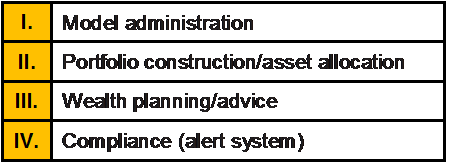
Section A (1 Mark)
If the deceased has two widows, four sons and two daughters then what is the share of each widow
Section B (2 Mark)
The Motor Vehicle Insurance Policy has inbuilt cover for death/disability of driver/owner caused by accident during the use of the insured motor vehicle up to Rs. __________ in case of car/commercial vehicle and Rs. _________ in case of two wheelers.
Section C (4 Mark)
Read the senario and answer to the question.
Saxena is considering an attractive investment proposal in which he is being offered two different cash flow choices at the same initial investment of Rs. 2,00,000. According to you which one should he opt for assuming Risk Free Interest Rate is the required rate of return?
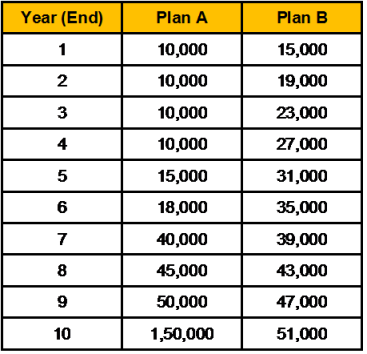
Section C (4 Mark)
Which of the following statements are correct?
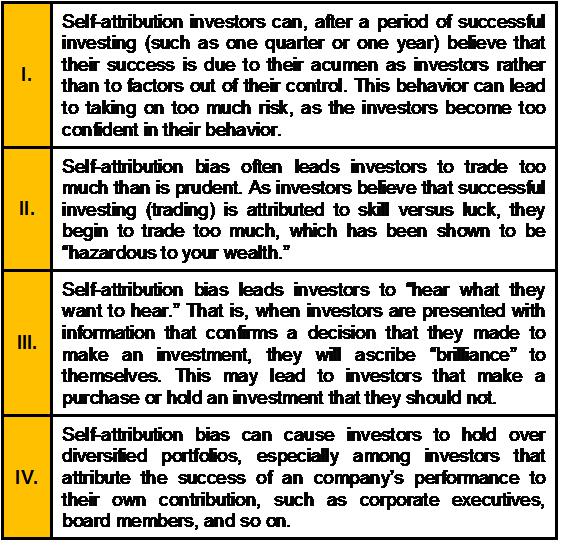
Section A (1 Mark)
Debt ratio is
Section A (1 Mark)
In order to have confirmation of a major market trend under the Dow Theory, the
Section A (1 Mark)
If the proposer does not disclose fully all the material facts at the time of Proposal the principle violated
Section A (1 Mark)
Real estate property consists of:
Section A (1 Mark)
All of the following are examples of capital expenditures except:
Section A (1 Mark)
A firm has a higher asset turnover ratio than the industry average, which implies
Section A (1 Mark)
A company making an IPO can avail which of the following option?
Section C (4 Mark)
Read the senario and answer to the question.
Calculate the income chargeable to tax from rented flat of Kolkata, for the assessment years 2008–09 and 2009–10.
Section A (1 Mark)
A good wealth management plan must include an analysis of all of the following EXCEPT
Section B (2 Mark)
The two aspects of Regret bias are_____________ and _____________.
Section A (1 Mark)
In ________, the values exchanged by the contracting parties may not necessarily be equal
Section A (1 Mark)
Deduction under section 80RRB is allowed to the extent of:
Section C (4 Mark)
Shikha has an investment portfolio of Rs.100000, a floor of Rs.75000, and a multiplier of 2. So the initial portfolio mix is 50000 in stocks and 50000 in bonds. If stock market goes up by 20%, what should Shikha do?
Section A (1 Mark)
The information in your credit report is primarily used by the credit bureau to compute your
Section C (4 Mark)
Medicon is one the world's largest manufacturer of implantable biomedical devices, reported earnings per share in 1993 of Rs3.95, and paid dividends per share of Rs0.68. Its earnings are expected to grow 16% from 1994 to 1998, but the growth rate is expected to decline each year after that to a stable growth rate of 6% in 2003. The payout ratio is expected to remain unchanged from 1994 to 1998, after which it will increase each year to reach 60% in steady state. The stock is expected to have a beta of 1.25 from 1994 to 1998, after which the beta will decline each year to reach 1.00 by the time the firm becomes stable. (The Risk Free rate is 6.25%.)
Estimate the value per share, using the three-stage dividend discount model.
Section C (4 Mark)
Which of the following statements is/are correct?
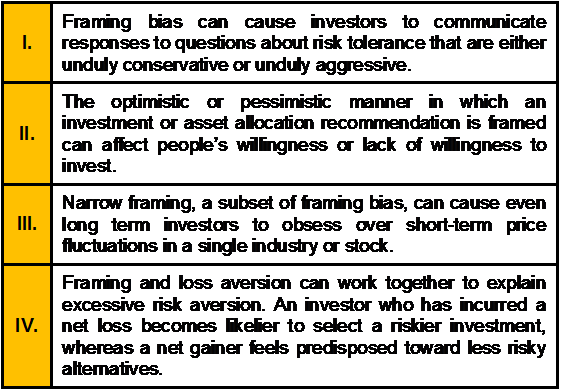
Section B (2 Mark)
Consider these two investment strategies:
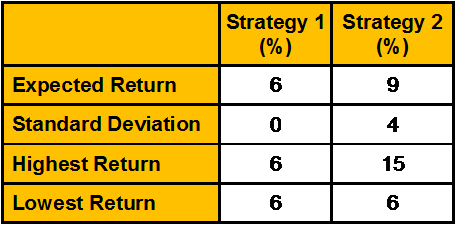
Strategy ___ is the dominant strategy because __________.
Section A (1 Mark)
The length of the insurance industry’s business cycle is shortened because of
Section C (4 Mark)
Singhvi group has recently announced that expected dividends for the next three years will be as follows:
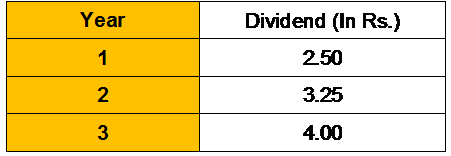
For the subsequent years, management expects the dividend to grow at 5% annually. If the risk-free rate is 4.30%, the return on the market is 10.30% and the firm’s beta is 1.40. What is the maximum price that you should pay for this stock?
Section B (2 Mark)
Which of the following statements with respect to DTAA is/are correct?
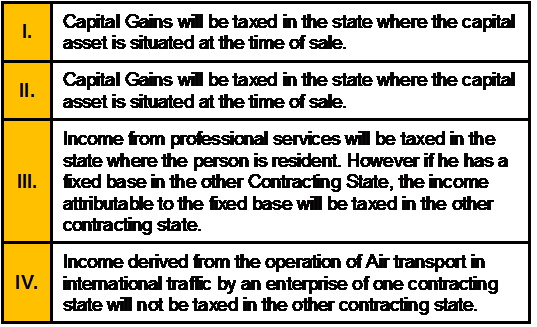
Section B (2 Mark)
Which of the following Biases are exhibited by Independent Individualist?
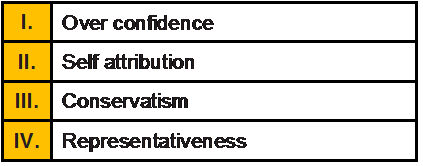
Section A (1 Mark)
Which of the following is/are correct?
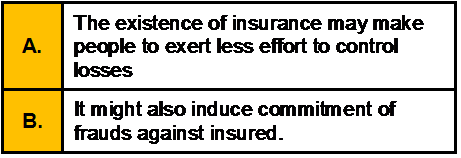
Section C (4 Mark)
Shekhar has an investment portfolio of Rs.100000; the initial portfolio mix is Rs. 50000 in stocks, Rs.30000 bonds and Rs.20000 in bank. If stock market goes up by 10%, what should Shekhar do under the constant mix policy?
Section A (1 Mark)
Income from which trust is added to the beneficiary’s taxable income?
Section C (4 Mark)
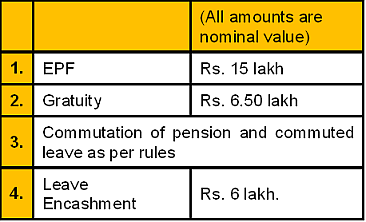 Mr. Vinay, aged 36 years is working in a company, at a managerial level, and has an income of Rs. 40,000 p.m. comprising of Basic salary and DA as on 31/03/2008. His other allowances amount to Rs. 18,000 p.m. He would retire at the age of 60 years. His wife Reena, aged 32 years, is working in a High School and has a post-tax income of Rs. 2,76,000 per annum. Mr. and Mrs. Vinay have two daughter Deepika, aged 10 years and Rekha, aged 5 years.
Mr. Vinay, aged 36 years is working in a company, at a managerial level, and has an income of Rs. 40,000 p.m. comprising of Basic salary and DA as on 31/03/2008. His other allowances amount to Rs. 18,000 p.m. He would retire at the age of 60 years. His wife Reena, aged 32 years, is working in a High School and has a post-tax income of Rs. 2,76,000 per annum. Mr. and Mrs. Vinay have two daughter Deepika, aged 10 years and Rekha, aged 5 years.
Mr. Vinay’s father died of heart attack, 5 months back, at the age of 72 years, leaving a house (Value as on date Rs. 30 lakh) in which Vinay is staying at present and other assets worth Rs. 20 lakh (shares of large cap companies worth Rs. 10 lakh, Fixed deposit in post office of Rs. 5 lakh and Bank FD of Rs. 5 lakh) in Vinay’s mother’s name. His mother 63 years old is disabled and fully dependent on Vinay, he being the only child of his parents. Vinay has to keep an attendant for his mother, round the clock.
The Assets of the Couple are:
1.Cash in HandRs. 18,000
2.Bank balanceRs. 40,000 (Vinay) Rs. 25,000 (Reena)
3.JewelleryRs. 400000 (Reena)
4.Money Market Mutual FundRs. 3,00,000 (Vinay)
5.Shares
?ICICI Bank 200 shares bought at Rs. 1000 per share,
?Infosys 150 shares bought at Rs. 1700 per share
?Reliance Communication 350 shares bought at Rs. 350 share.
6.Debt oriented mutual FundsRs. 2,00,000
7.PPFRs. 5,00,000 (Vinay), Rs. 4,00,000 (Reena)
8.House in the joint name of Vinay and Reena with 50% ownership of each. This house has two floors and is let out for Rs. 9,000 pm for each of the floors. Present value of this house is Rs. 60,00,000.
Vinay and Reena had taken a housing loan of Rs. 15,00,000 each. Of this Rs. 10,00,000 is pending on each name. They are presently paying an EMI of Rs. 20,000 each, Rate of interest being 10.75% p.a.
The Retirement Benefits of Vinay after 15 years hence, are expected to be as follows:
Vinay has taken a term insurance of Rs. 30 lakh for 20 years, which is expiring 5 years from now. He has no other insurance. Vinay’s monthly household/ living expenses are Rs. 50,000. This excludes EMI on loans but includes all other expenses including expenses on his mother’s care.
Vinay expects Deepika to get married 12 years hence for which likely expenditures in today’s term is 15 lakh.
Vinay’s salary is likely to grow at 7% pa and Reena’s salary is likely to grow at 6% p.a. Risk free rate of interest is 8% pa and inflation is 6% p.a. Long term growth on Equity/Equity based MF is taken as 15% p.a.
Section A (1 Mark)
The two major types of real estate are ____ and ___ .
Section C (4 Mark)
Read the senario and answer to the question.
Calculate income from House property for Mr. Keshav for assessment year 2010-11.
Section A (1 Mark)
In a bull spread, the investor makes profits if market goes
Section A (1 Mark)
Multi period hedging is ________
Section C (4 Mark)
Read the senario and answer to the question.
Jogen commuted his 40% of pension in April, 2008 with Rs. 2,15,000.What would be the taxable amount on commuted pension received by Jogen, if he would retire from a private organization?
Section B (2 Mark)
Vikrant Juneja gifted his house property to his wife in year 2007. Mrs. Juneja then lets out this house @ Rs. 5000 per month. The income from such house property will be taxable in the hands of:
Section A (1 Mark)
Which of the following is not true about traditional defined benefit plans?
Section A (1 Mark)
Premium under endowment plans equals
Section A (1 Mark)
REITs offer all of these, except:
Section A (1 Mark)
The slope of the CML is the:
Section B (2 Mark)
A person is treated as being UK resident for a tax year if he or she is physically present in the UK for at least ___ days in the year or makes regular visits to the UK averaging at least ___ days per year. Fill in the blanks.
Section A (1 Mark)
Onshore wealth management involves ____________
Section B (2 Mark)
Amit has just received new information regarding his investment in PLC ltd. The new information appears to be in conflict with earlier forecast of what the stock price should be at this point. He is still willing to incorporate the new information into his forecast and to revise it accordingly.
Which behavioral heuristic is Amit displaying?
Section A (1 Mark)
Monetary policy is determined by
Section B (2 Mark)
An appraiser estimates that a property will produce NOI of Rs 25,000, the Yo is 11 percent, and the growth rate is 2.0 percent. What is the total property value (unrounded)?



